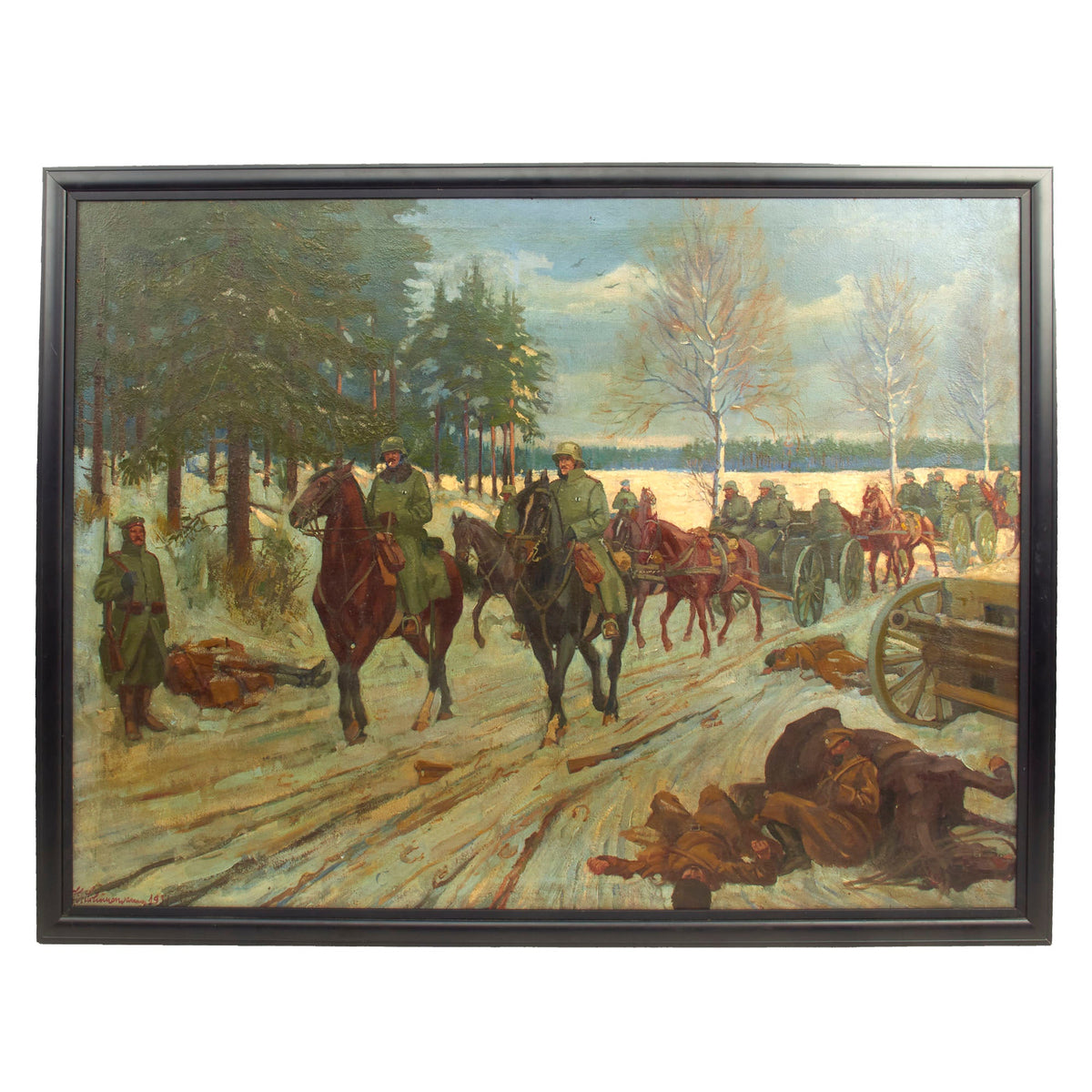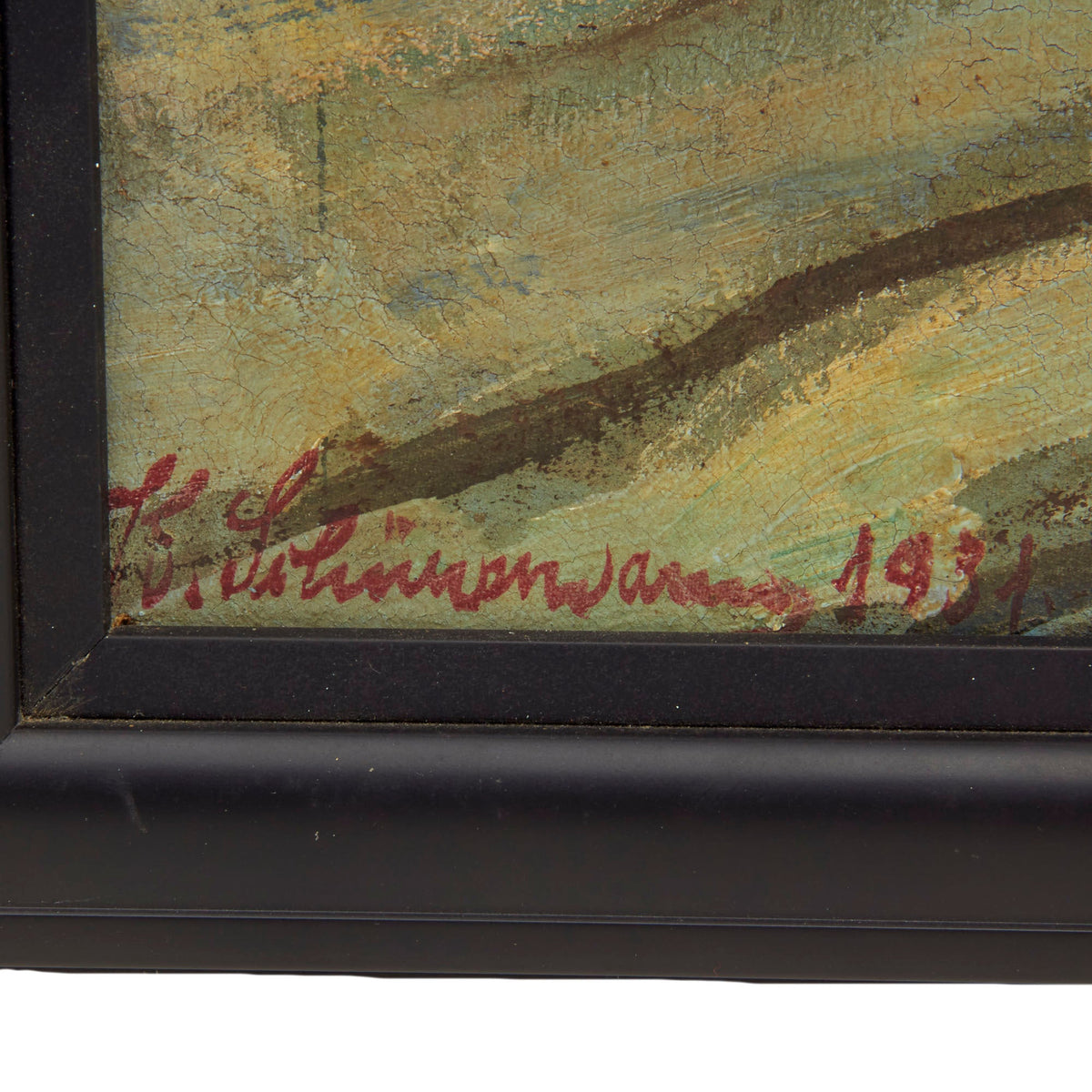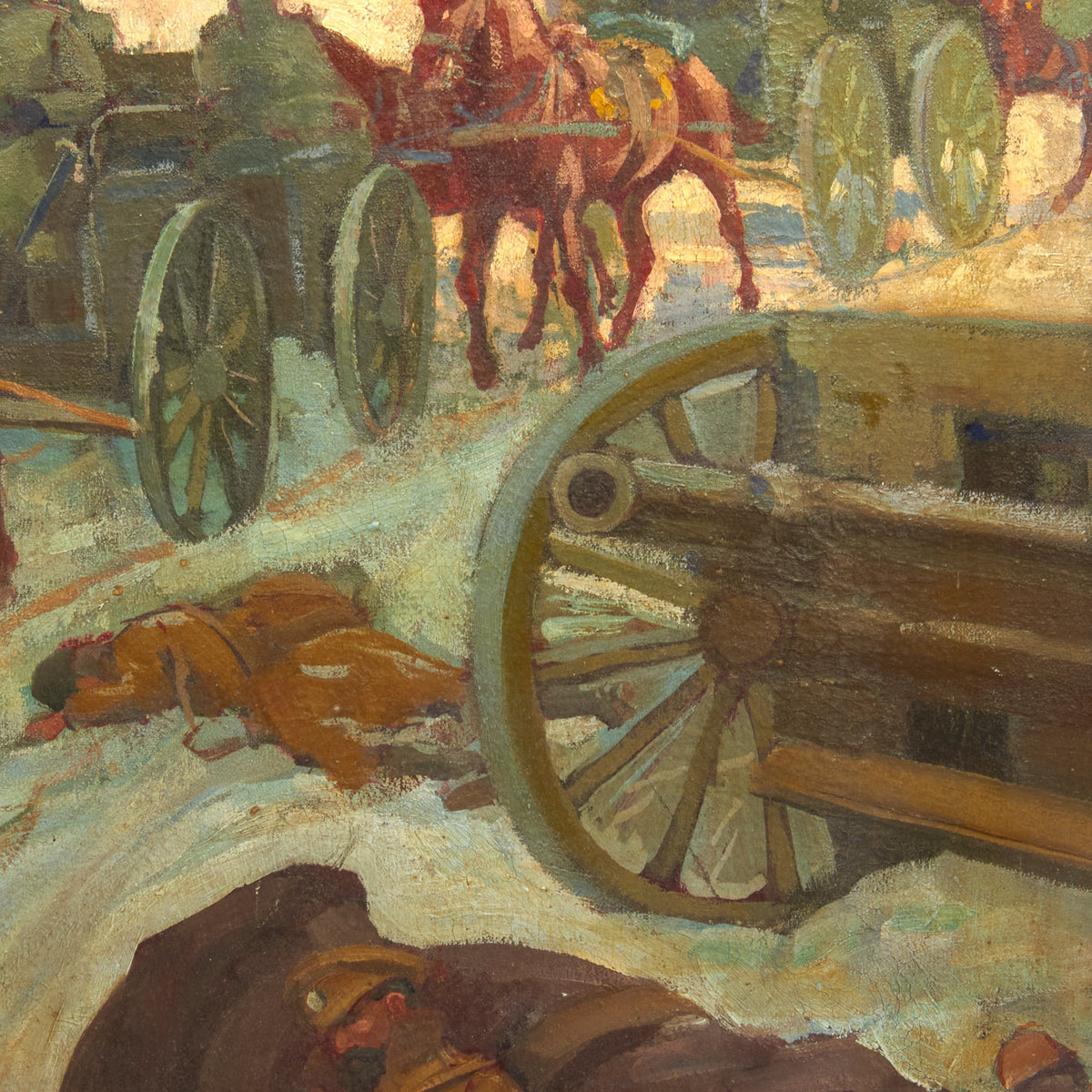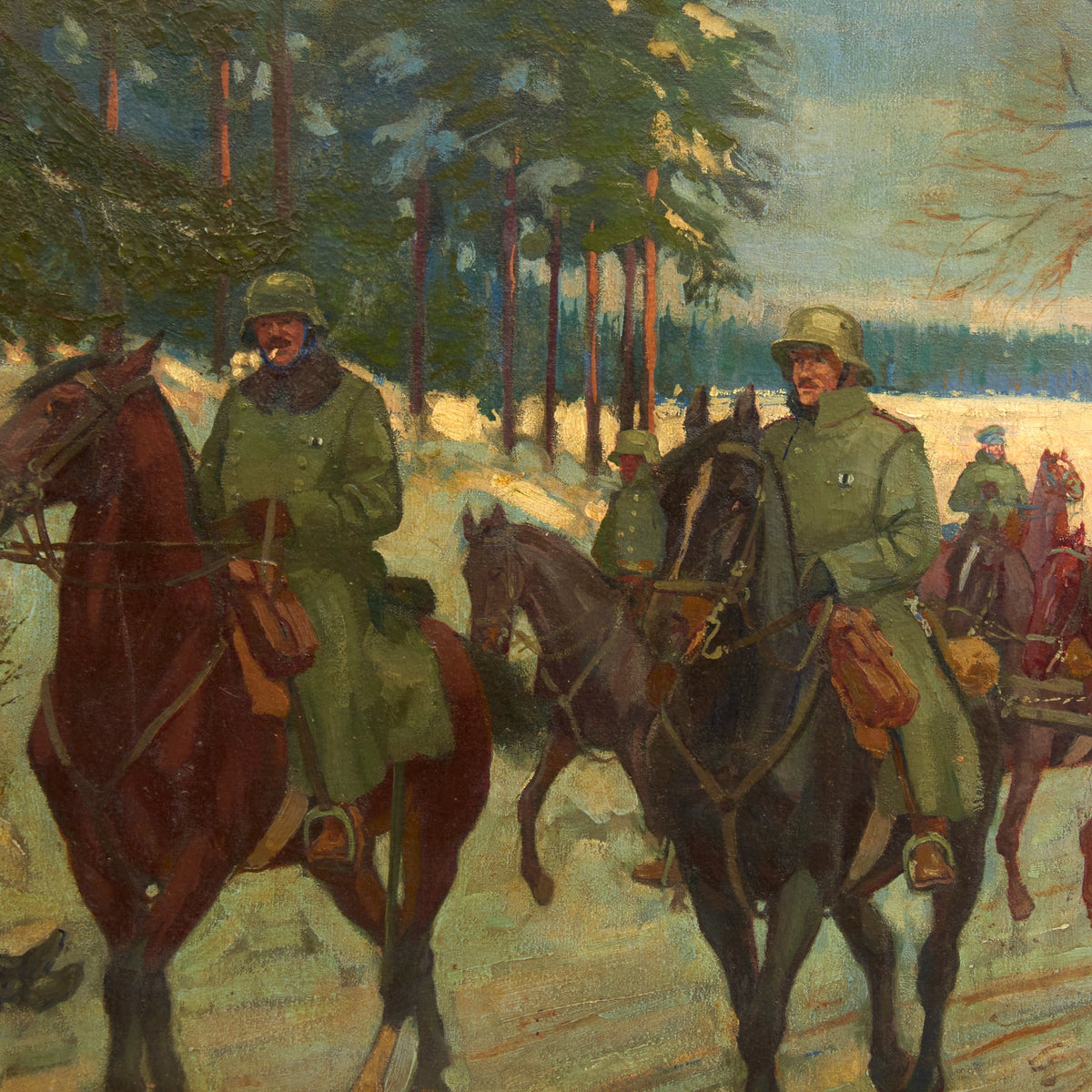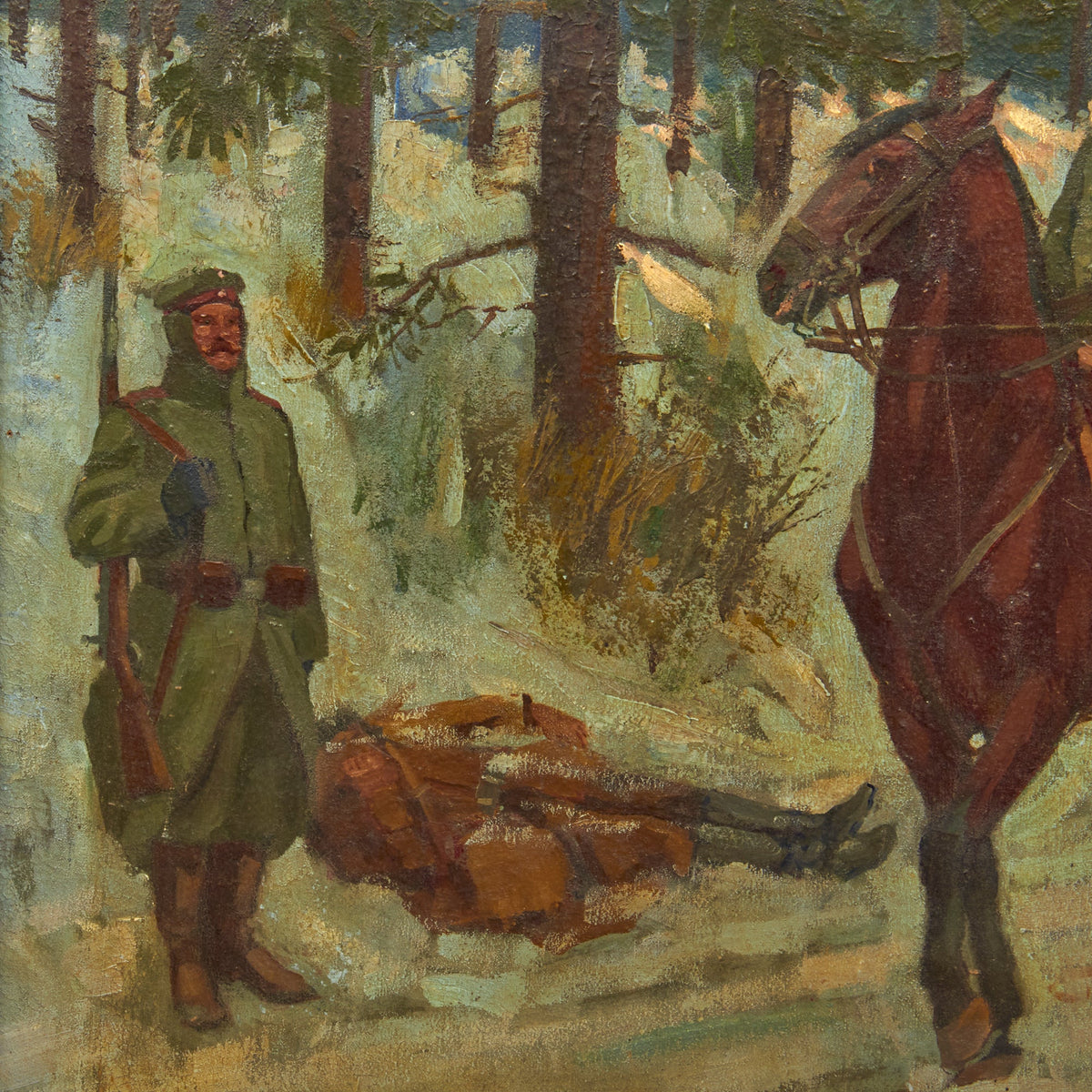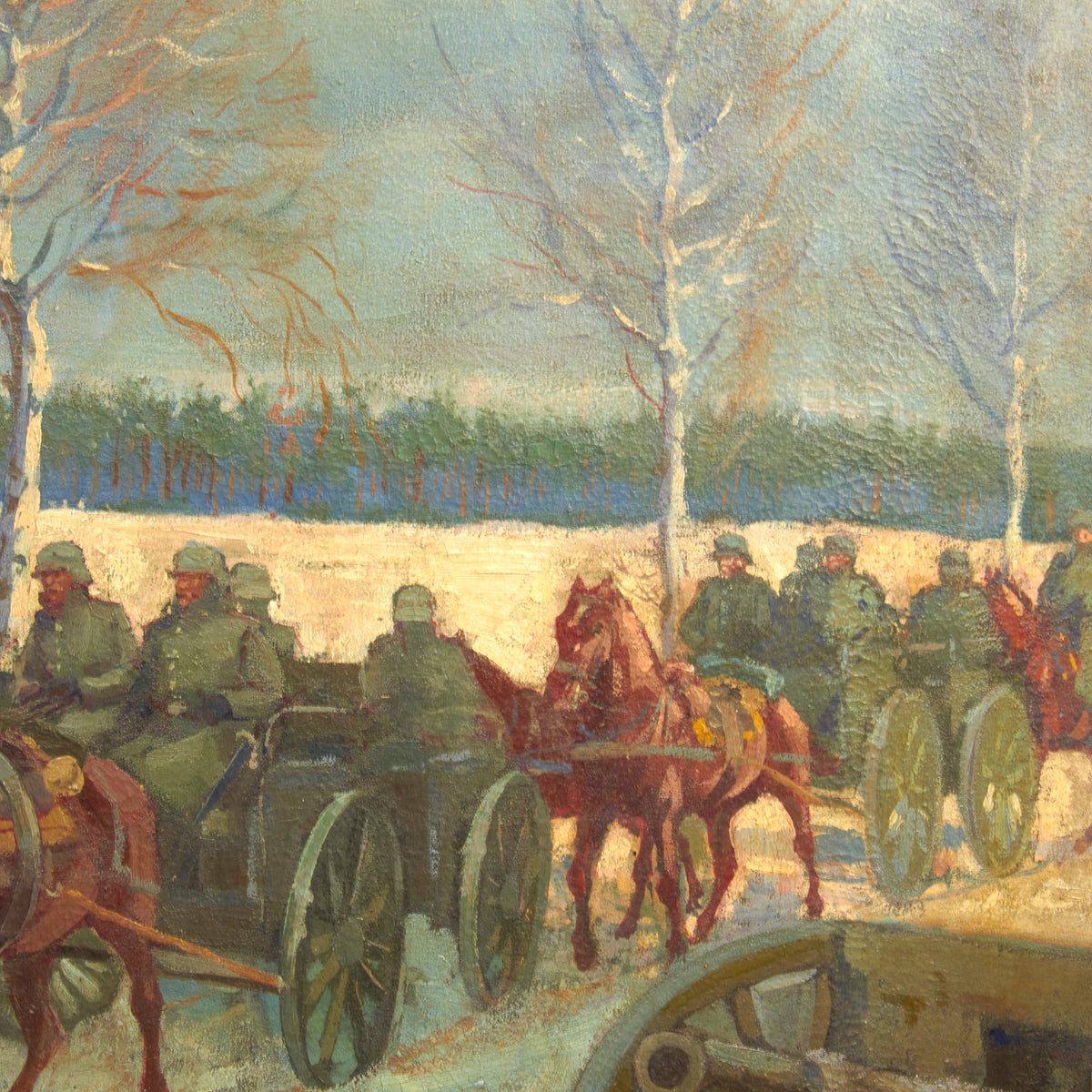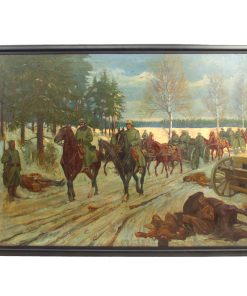Original German WWI Era Oil Painting of an Artillery Column on the Eastern Front – Signed and Dated 1931 – 28 1/2″ x 38 1/2″ Original Items
$ 1.095,00 $ 273,75
Original Item: One-of-a-kind. Here we have a very nice oil on canvas painting of an Imperial German Army Artillery Column, on the march during the winter during World War I. It shows German soldiers on horses in the front, followed by a train of horses towing artillery pieces, each of which has 4 soldiers along for the ride. The road is snow and mud covered, and there are Imperial Russian soldiers lying dead on the ground to the sides of the road. The painting is very well executed, full of color and detail. In the frame it measures 31 3/8″ x 41 3/8″, with the exposed canvas measuring 28 1/2″ x 38 1/2″. The framing is very well done, and looks to have been redone relatively recently at some point probably about 10 years ago, based on the label on the back.
There is a signature in the lower left of the painting, which definitely looks to be a German name, however we cannot quite make out what it says. Next to this is a date of 1931, just a few years before the NSDAP takeover, when Germany had already been clandestinely re-arming. It’s very possible that this painting was sold to help raise war funds for the Reichswehr.
Definitely an interesting and unique piece of WWI Memorabilia! Ready to research and display!
The Eastern Front or Eastern Theater of World War I (German: Ostfront; Romanian: Frontul de răsărit; Russian: Восточный фронт, romanized: Vostochny front) was a theater of operations that encompassed at its greatest extent the entire frontier between Russia and Romania on one side and Austria-Hungary, Bulgaria, the Ottoman Empire, and Germany on the other. It stretched from the Baltic Sea in the north to the Black Sea in the south, involved most of Eastern Europe, and stretched deep into Central Europe as well. The term contrasts with the Western Front, which was being fought in Belgium and France.
During 1910, Russian General Yuri Danilov developed “Plan 19” under which four armies would invade East Prussia. This plan was criticised as Austria-Hungary could be a greater threat than the German Empire. So instead of four armies invading East Prussia, the Russians planned to send two armies to East Prussia, and two armies to defend against Austro-Hungarian forces invading from Galicia. In the opening months of the war, the Imperial Russian Army attempted an invasion of eastern Prussia in the Northwestern theater, only to be beaten back by Germany after some initial success. At the same time, in the south, they successfully invaded Galicia, defeating the Austro-Hungarian forces there. In Russian Poland, the Germans failed to take Warsaw.
But by 1915, the German and Austro-Hungarian forces were on the advance, dealing the Russians heavy casualties in Galicia and in Poland, forcing them to retreat. Grand Duke Nicholas was sacked from his position as the commander-in-chief and replaced by Tsar Nicholas himself. Several offensives against the Germans in 1916 failed, including the Lake Naroch Offensive and the Baranovichi Offensive. However, General Aleksei Brusilov oversaw a highly successful operation against Austria-Hungary that became known as the Brusilov offensive, which saw the Russian Army make large gains. Being the largest and most lethal offensive of World War I, the effects of the Brusilov offensive were far reaching. It helped to relieve the German pressure during the Battle of Verdun, while also helping to relieve the Austro-Hungarian pressure on the Italians. As a result, the Austro-Hungarian Armed Forces were fatally weakened, and finally Romania decided to enter the war on the side of the Allies. However, the Russian human and material losses also greatly contributed to the Russian Revolutions.
Romania entered the war in August 1916. The Allied Powers promised the region of Transylvania (which was part of Austria-Hungary) in return for Romanian support. The Romanian Army invaded Transylvania and had initial successes, but was forced to stop and was pushed back by the Germans and Austro-Hungarians when Bulgaria attacked them from the south. Meanwhile, a revolution occurred in Russia in March 1917 (one of the causes being the hardships of the war). Tsar Nicholas II was forced to abdicate and a Russian Provisional Government was founded, with Georgy Lvov as its first leader, who was eventually replaced by Alexander Kerensky.
The newly formed Russian Republic continued to fight the war alongside Romania and the rest of the Entente in desultory fashion. It was overthrown by the Bolsheviks in November 1917. Following the Armistice of Focșani between Romania and the Central Powers, Romania also signed a peace treaty with the Central Powers on 7 May 1918, however it was canceled by Romania on 10 November 1918. The new government established by the Bolsheviks signed the Treaty of Brest-Litovsk with the Central Powers in March 1918, taking it out of the war; leading to a Central Powers victory on the Eastern Front and Russian defeat in World War I.
Fast Shipping with Professional Packaging
Thanks to our longstanding association with UPS FedEx DHL, and other major international carriers, we are able to provide a range of shipping options. Our warehouse staff is expertly trained and will wrap your products according to our exact and precise specifications. Prior to shipping, your goods will be thoroughly examined and securely secured. We ship to thousands clients each day across multiple countries. This shows how we're dedicated to be the largest retailer on the internet. Warehouses and distribution centres can be located throughout Europe as well as the USA.
Note: Orders with more than one item will be assigned a processing date depending on the item.
Before shipping before shipping, we'll conduct a thorough inspection of the items you have ordered. Today, the majority of orders will be delivered within 48 hours. The delivery time will be between 3-7 days.
Returns
The stock is dynamic and we cannot completely manage it because multiple stakeholders are involved, including our factory and warehouse. So the actual stock may alter at any time. It's possible that you may not receive your order once the order has been made.
Our policy is valid for a period of 30 days. If you don't receive the product within 30 days, we are not able to issue a refund or an exchange.
You can only return an item if it is unused and in the same state as the day you received it. You must have the item in its original packaging.
Related products
Uncategorized
Angolan Rebel 1970s era 60mm Inert Display Mortar from Angolan Civil War Original Items
Uncategorized
Uncategorized
Uncategorized
Uncategorized
Band of Brothers ORIGINAL GERMAN WWII Le. F.H. 18 10.5cm ARTILLERY PIECE Original Items
Uncategorized
Uncategorized
Uncategorized
Uncategorized
Uncategorized
Uncategorized
Uncategorized
Armoured Fighting Vehicles of the World: AFVs of World War One (Hardcover Book) New Made Items
Uncategorized
Uncategorized
Uncategorized
Uncategorized
